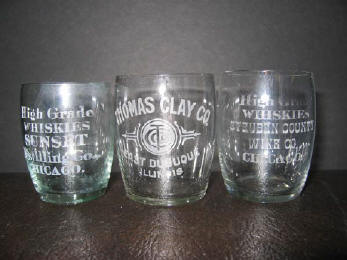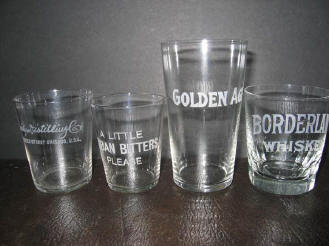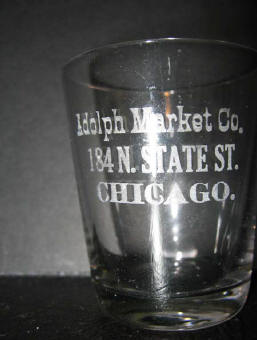|
THE SHOT GLASS - IS IT
ART, HISTORY, OR A LITTLE OF BOTH? |
The
Summer 2004 issue of Bottles and Extras featured Howard Currierís
article on the vast and varied collecting interests of Ed Sipos of
Scottsdale, Arizona. When Howard asks, "What advice would you offer to
young collectors just starting out?" Ed replies, "I think young
collectors should focus on acquiring good condition glasses with nice
graphics and few flaws. One day weíll all have to let go of our
collections, so if you stick with more desirable glasses in clean
condition, youíll make it much easier on yourself later on. If you have
a certain region that appeals to you, or type of glass you like, that
can be a good start also."
I have been reflecting on Edís comments ever since. Two thoughts
repeatedly come to mind: One, do we collect shot glasses because they
are art, history, or a combination of both? Two, does the answer to the
first question have any effect on Edís thoughts as an overall collecting
philosophy?
It seems to me that there are three broad groups of shots. First of all,
there are shots that are pure art. Many of George Truogís glasses fall
into this category. Consider, for example, the "Night
Cap," "Eye
Opener," and the "Donít
Drown the (Pig.)"
I define history glasses as those that are all text with no graphics. Of
course we all have these in our collection; one of the most common is
the
Security Distilling Co. glass from Chicago. This is fairly "bare
bones" history, just the name of the company and its location. Other
glasses are more descriptive. Consider the
Mellow Springs Whiskey glass from St. Louis, which advertises the
prices of its whiskey right on the glass.
By default I include in this category text glasses that are so barren
that they contain no information at all about their company. "A
Little Cuban Bitters Please" is a classic example; others include "Golden
Age," "Borderland Whiskey," or "Mohican Whiskey" (below).
Thankfully, because of the work of Bob
Snyder, Howard Currier, Barb Edmonson, and Robin Preston, we are
learning more and more about these glasses, and so they probably belong
in this category and not in a separate group that is devoted solely to
"mystery" glass.
Finally, there are glasses that are both history and art. One glass that
truly illustrates this concept was in Robinís
February 8, 2004, Shot of the Week. This Father Time Old Elgin Rye
Whiskey features gorgeous graphics and interpretative text that
indicates that it hails from Elgin, Illinois. Another is the Remington
Liquor Co. glass from Portland, Oregon; it was featured in the
September 12, 2004, Shot of the Week.
So what is the relationship between these three broad fields and our
collecting interests? "Art" glasses seem to be popular. Robin Prestonís
article on George Truog appeared in the
Fall 2004 issue of Bottles and
Extras. He writes that auction prices on some of Truogís novelty
glasses have risen spectacularly in the last two years as awareness of
them grows--from only $20 to over $150! (Oh, to own a time machine. . .
.)
There seems to be a similar (if not greater) demand for art/history
glasses. Robin notes that the Father Time glass sold on eBay for $261.99
and that a Remington glass went for $300 in December 2002 when it was
listed on a pre-pro sales page. Thus, the marketplace seems to be in
line with Edís comments--graphics are good.
But what about history? It seems that scarcity can increase
desirability, graphics or no graphics. See, for example, the "Pride
of North Carolina Corn Whiskey" glass featured in the June 12, 2004,
SOTW. This glass featured no graphics, only text, but garnered an
eBay bid of $167.50 that did not meet the even higher reserve price. A
peek at the pre-pro data base reveals an almost total dearth of North
Carolina glass, and so this unlisted shot garnered much attention.
Similarly, although for the most part the A.M. Smith "Merry Xmas" shots
have no graphics, many collectors are trying to obtain a complete set of
these glasses. Finally, a glass that merely contained the (albeit
enamel) words "Old Settlerís Club Whiskey" sold recently on eBay for
$258.88.
But scarcity is no guarantee of desirability. I have an unlisted Chicago
glass that bears the name of Adolph Market Co (below). I have never seen
it on eBay since I purchased it about six months ago, and although it
might be uncommon, I dare say that this shot would garner little
interest on eBay if I were to list it tomorrow, even if the etching were
stronger than on my example.
All this leads me to conclude that although there are exceptions to this
rule, if you want a maximum return on your investment, collectors should
collect "art" and "art/history."
But should one collect glass solely with an eye to the future, to that
time when you decide to sell your collection? No, not at all. I think
that you should collect what you want to collect. Collect for fun, and
if your collection happens to go up in value, well, thatís better still.
And Ed seems to suggest this when he adds that one can collect a state
that he or she is interested in.
For example, consider collecting your home state. If you live in North
Carolina, well, collect a state you are interested in. Illinois, e.g.,
has tons of great-looking glass, and much of it is not expensive.
Ed adds that one could even collect a shape of glass. I found this
comment to be especially interesting. I confess that I have always been
intrigued by the "barrel" shot glass (See
page 9 in Historic
Shot Glasses.) If one wants to collect glasses from all over the
United States, but still wants to have a limited collecting scope
because of budget constraints, I think that a shelf of "barrel" glass
(much of which seems to be "history" glass), would look truly nifty.
Consider, for example, the examples shown here. (Barrel glasses donít
seem to be as common as the more conventionally shaped glasses. I note
that the etching is worn on two of the three examples in my Illinois
collection. I wonder if the etching wore down prematurely because of the
shape. Is it possible that because of this, the shape was not very
popular? Or is it just that I have some poorer examples?)

And who knows? As we learn more about a glassís history, perhaps the
"history" glasses will become more and more valuable. For example, Robin
writes in his article about George Truog that the
Dr. Petzholdís German Bitters glass (a "history" glass), was etched
by Truog and in fact bears his tell-tale GT signature!
|



